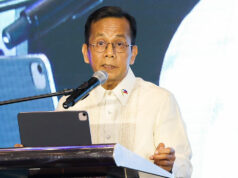Energy World Philippines gets go signal to build LNG facility
By Victor V. Saulon
Sub-editor
THE local unit of Australia’s Energy World Corp. Ltd. (EWC) has taken the lead in the race to build an integrated liquefied natural gas (LNG) facility in the Philippines as its proposal has been cleared by the Department of Energy (DoE).
In a letter dated Jan. 2 to the Australian Securities Exchange, EWC said DoE Secretary Alfonso G. Cusi on behalf of the department had issued Energy World Gas Operations Philippines, Inc. a permit to construct, own and operate an LNG import terminal and regasification facility on Pagbilao Grande island in Quezon province.
“The permit which was issued on 21 December 2018 forms an update to the original permit documentation and provides for a further construction period of 24 months from the permit issue date,” it said.
EWC said the permit would enable the completion date for the first tank of the LNG hub to be aligned to the commercial operation date of the associated 650-megawatt (MW) power plant and the National Grid Corporation of the Philippines switchyard expansion, which is under construction, and for the construction of the second tank.
Separately, Rino E. Abad, director of the DoE’s Oil Industry Management Bureau, told reporters on Thursday that EWC is now leading as far as permitting is concerned.
Mr. Abad said EWC’s proposal was the first to be endorsed by the centralized review and evaluation committee (CREC) for Mr. Cusi’s approval. He said the proposal was simply an extension of EWC’s previously approved project that had encountered delays because of funding issues.
The proposal of Phoenix Petroleum Philippines, Inc. and its Chinese partner China National Offshore Oil Corp. (CNOOC) is currently being evaluated by CREC, he said.
First Gen Corp. and its partner Tokyo Gas Co., Ltd. were the last to submit its project proposal, which is now under evaluation by Mr. Abad’s group for compliance with financial, technical and legal requirements.
Mr. Abad said the issue with EWC’s previous application was mainly on the extension of the project’s previously issued permit.
“The problem is nag-submit siya ng work program pero hindi niya ma-explain ‘yung budget (The problem was it submitted a work program but it was not able to explain its budget.),” he said.
Mr. Abad said the TWG (technical working group) had asked EWC to substantiate its application since at that time, the unfinished project needed around P6 billion to be completed. He said the company had replied with supporting documents, including approval from shareholders that they would release a special fund for the project’s completion.
“Ang sa amin naman as long as hindi masyadong vague ‘yung plano ‘yan naman ay ine-encourage natin, sinusuportahan ‘yung investors (From our end, as long as the plan is not too vague, we encourage it and support the investors.),” Mr. Abad said.
He also said that EWC also explained that the release of funds by local lenders depends on the approval by the DoE of the extension permit.
In an earlier interview, EWC Director Graham S. Elliott said the company had resumed talks with local lenders to fund the completion of its 650-MW combined cycle gas-fired power plant.
“We are in the process of finalizing the project funding from the Development Bank of the Philippines and Land Bank [of the Philippines] and other institutions, and hopefully we’re about six to eight months away from commercial operation of the first 200-MW gas turbine,” Mr. Elliott had said.
Francis Nicolas M. Chua, DBP first vice-president and head of the bank’s corporate finance group, confirmed the revival of talks with EWC.



